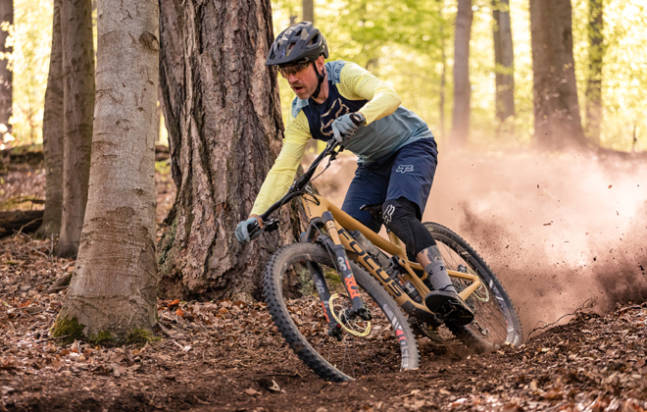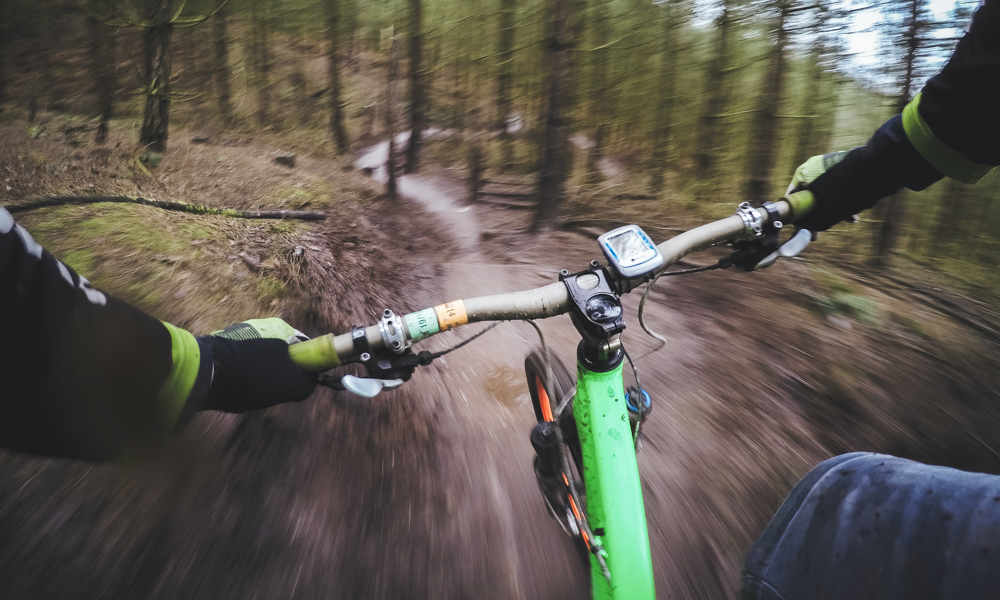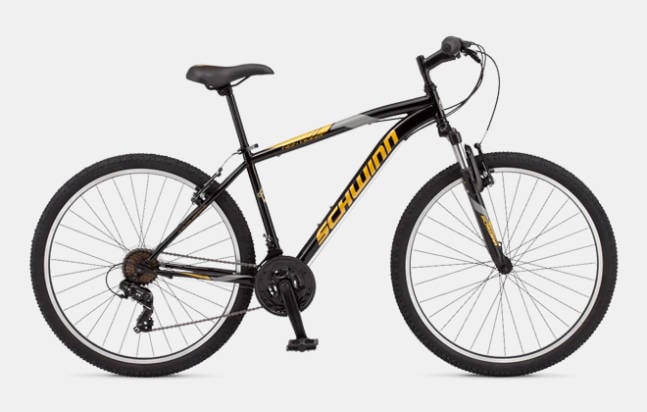The first thing I saw the day I moved into my college dorm room in Colorado was a black and gray Trek Big Sur mountain bike leaning carefully against the frame of my assigned roommate’s bed. Though I never became close with the guy – we lived together only a couple of months – he did pass on to me one important nugget of wisdom that proved invaluable in the ensuing years. On the day I met him, he said, “You should really start mountain biking. It’s almost as fun as snowboarding, and you can do it anywhere.”
Though I believed him, I had no idea how to get started. I didn’t know that there were different types of mountain bikes, or even that our nearby ski area allowed you to hitch a bike onto the back of the chairlift in the summer and cruise down the hill in style while avoiding the pesky ascent. I decided to pick up a new hobby that day that has stuck long beyond my college years.
Here’s everything you need to know to get started.

How to Start Mountain Biking
The sport can be done alone, though it doesn’t have to be. Depending on where you live, there may be local groups on MeetUp or elsewhere that regularly organize rides, making mountain biking a great way to meet new people and expand your social circle. Regardless of whether you take solo or groups trips, few things can match the feeling of ripping high around a berm and cruising through an alpine forest on a sunny summer day.
Starting any new hobby, particularly an outdoor one, requires not only the commitment to learn and progress but also requires the gear necessary to succeed and have fun. Making that commitment ultimately falls on you, but it’s easier to be committed when you know the lingo, the types of mountain bikes, the best bicycles for men, and which one is right for you.
Types of Mountain Bikes
When choosing a beginner mountain bike, it’s important to have a firm grasp of the types of mountain bikes available. Otherwise, you may end up with one that isn’t suited for the kind of riding you want to do.
There are several different disciplines to mountain biking, but as a beginner, you should concern yourself with just two of them: downhill and cross-country. Cross-country riding is the most common form of mountain biking for beginners because it’s easier to learn on flatter terrain and progress from there.
The first thing you’ll be asked at a bike shop is whether you want a rigid, hard-tail, or full-suspension bike.
Rigid bikes
Rigid bikes have no suspension, meaning they cannot absorb impact and therefore are not suitable for anything but the most basic of trail riding.
Hard-tail bikes
Hard-tail bikes have front suspension but a fixed back wheel. These bikes are generally more affordable than full-suspension bikes and are easier to learn on.
Hard-tail bikes are generally well-suited to entry-level cross-country riding as trails or paths can include both ascents and descents as well as long flat sections. Cross-country bikes are built to be durable enough for anything you might encounter on a basic trail, including rocks, berms, and small bumps. They’re able to ascend with prowess and seamlessly transition the rider into a descent.
Full-suspension bikes
Full-suspension bikes have suspension on both wheels and are designed for bumpier, more technical terrain.
Downhill bikes are always full-suspension bikes, or dualies, in the parlance of the sport, meaning there are shock absorbers on both axles with at least 50mm to 75mm of suspension travel (how much the shocks can compact to absorb impact). These are built for speed, shock absorption, and steep descents.
Additionally, if you plan to head to bike parks at ski resorts, you’re going to want to buy a full-suspension mountain bike.

Mountain Bike Lingo That You Need to Know
Like any subculture, mountain bikers have their own terminology for gear, conditions, and situations. Much of this you’ll pick up on within the first few rides, but there are some terms you should learn in advance, as shop staff are going to use them when you head in to buy your beginner mountain bike. Understanding what they mean will help you ride out of there with the perfect set of wheels.
Berm: A banked corner commonly found on downhill mountain bike trails. A berm makes it easier to turn around on a switchback without washing out.
Clipless: Somewhat confusingly, clipless pedals are bike pedals that allow the rider to clip in a specific bike cleat to make it easier to get into a pedal flow, sort of like ski bindings.
Dualie: A dualie is a full-suspension bike that absorbs shock at both ends.
Enduro: Style of mountain bike racing consisting of both cross-country and downhill riding.
Hardtail: A hardtail is a mountain bike with suspension only on the front fork.
Hero dirt: Dirt that is fast and maintains grip on the tires. These are the best conditions for mountain biking, often found in the days following a rain storm.
Platform: Platform pedals are standard bike pedals that don’t allow clip-in cleats. Most beginner mountain bikes come with platform pedals, and if the sales rep you buy from asks whether you prefer clipless or platform pedals on your new bike, your best bet is platform.
Singletrack: Narrow trails wide enough for only one rider, and sometimes only allowing travel in one direction.
Travel: How much shock the front fork and rear shock absorber can take, measured in millimeters that the fork or shock moves up and down upon impact.
Tubeless: Tubeless tires are sealed with a sealant that holds air without requiring an inflated tube. This reduces the frequency of flats.
Best Mountain Bikes for Beginners
Now that you’re ready to hop on, these are the best entry-level mountain bikes to get you started. Each of the below five are the best bicycles for men looking to find their footing on the trail, depending on where you plan to ride.

Best Mountain Bike for Long-term Use: Giant Talon
The best beginner mountain bike for riders looking to ease into all aspects of the sport is the Giant Talon. This bike is available in a 29” or 27.5” aluminum frame. I learned to ride on a Talon 27.5” – a bike big enough for the average male rider but easier to feel in control of than the larger option. It’s designed for cross-country riding in varied terrain that can include frequent transitions between ascending and descending. Disc brakes and an 8-gear drivetrain offer reliable performance in varying conditions while allowing you to switch between upper and lower gears in a hurry (no shifting on a 3×6 or 3×7 drivetrain with 18 or 21 total speeds). What separates it from other entry-level mountain bikes is that the Talon comes in three styles: Talon 1, 2, and 4. Bikes progress from highest to lowest in terms of performance ability, but because each has 80mm of travel, even the Talon 1 is able to handle somewhat bumpy terrain. It’s also a great way to avoid having to buy another bike the minute you feel comfortable attempting a more challenging trail ride.
Best Mountain Bike for Rapid Progression: Co-op Cycles DRT 1.1
The Co-op Cycles DRT 1.1 mountain bike is designed and sold by REI. It’s a great deal at its price point because REI’s position as one of the nation’s largest outdoor retailers allows it to use top-quality, lightweight aluminum that’s normally found on more expensive bikes, as opposed to a heavier steel frame. The hardtail bike has 100mm of travel and hydraulic disc brakes capable of performing in any dirt condition, even with a little mud tossed in. With 21 gears on a Shimano drivetrain, you have more than enough gear options to shift between based on the terrain.
Best Mountain Bike for Blending Trails With Paved Paths: Cannondale Trail 8
With the Trail 8, Cannondale developed the perfect crossover mountain bike for beginners looking to blend trail and paved riding. I once rode a Cannondale Trail 8 from Denver’s west suburbs up to the top of Red Rocks Amphitheatre, a ride split perfectly in half by trail and paved paths. The bike handled the 1,000’ ascent in stride as I shifted down its 7-speed drivetrain in consistent 10-minute increments throughout the ride. On the descent, the disc brakes performed flawlessly even when I let loose down Trading Post Road. Its 75mm of travel isn’t going to save your knees in the bike park, but it’s perfectly suited for casual cruises down most trails.
Best Budget Mountain Bike Option: Schwinn High Timber
The Schwinn High Timber is the best option if you want to dip your toes into mountain biking to see if it’s for you. Its low price tag puts you on a decent learner’s bike without much upfront investment, and you’re still getting a 21-gear drive train on a 27.5” or 29”
frame. The downside is that this bike is made of steel, making it heavier than an aluminum bike and thus tougher to whip around sharp turns. However, that same steel frame makes this bike sure to last a long time even with frequent use, so if you ride a combo of road and dirt to work or to nights out on the town, you can’t go wrong with this bike. And hey, if cruising single track doesn’t prove to be your next deep passion, this bike makes for a great commuter bike.
Best Entry-level, Full-suspension Mountain Bike: Mongoose Salvo 29 Trail
Mongoose specializes in affordable mountain bikes, and its Salvo 29 Trail is the best entry-level mountain bike if you want dual suspension. Should you be among a group of friends who are experienced riders and you need to keep up, this bike’s lightweight aluminum frame and 100mm of travel with mechanical lockout for swapping between ascents and descents are exactly what you’re looking for. The bike is offered in 27.5” and 29” frames, making it ideal for anyone standing between 5’5” and well over 6’. Because Mongoose is a well-known brand, you can take this stead into the bike shop and the mechanic will be as amenable to working on it as any other full-suspension bike—something that can’t be said for the few cheaper full-suspension options out there.
Buy Now $1,250








